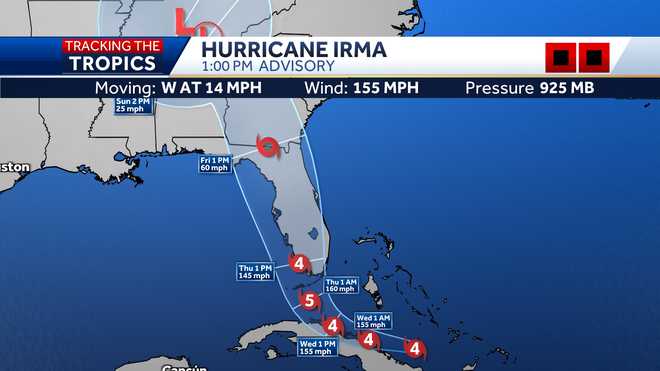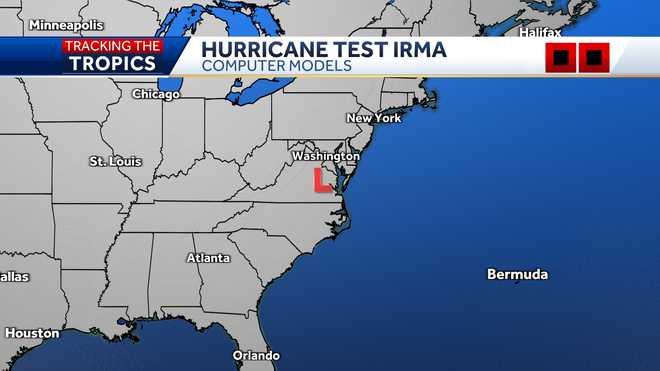Hurricane Erin churns up dangerous surf and rip currents along the East Coast
Hurricane Erin is churning up life-threatening rip currents and dangerous surf along much of the U.S. East Coast and will soon send destructive waves and storm surge to North Carolina’s Outer Banks. Meanwhile, Atlantic hurricane season is hitting its stride, threatening to spin up another named storm in Erin’s wake.
Erin, a sprawling Category 2 hurricane, is not forecast to make landfall but will impact much of the East Coast with dangerous coastal conditions as it tracks north, nearly paralleling the coast. Bermuda will face similar conditions to the storm’s east.
Preparations are ramping up along the coast with the worst of Erin’s impacts expected to begin Wednesday in North Carolina. Gov. Josh Stein declared a state of emergency on Tuesday to free up resources as the state’s coastal region readies up for the hurricane’s threats.
Erin is already creating dangers: Dozens of rip current rescues have been conducted in North Carolina, and popular beaches in Maryland, Virginia, Delaware and New Jersey, as well as all public beaches in New York City, have enacted no swimming decrees until Erin’s threat passes.
More than a dozen people were rescued at North Carolina’s Wrightsville Beach on Tuesday, following about 60 rescues at the beach Monday, according to Sam Proffitt, the town’s ocean rescue director.
The beach has issued a no-swim advisory through Friday, but Proffitt said most of those rescued have been beachgoers going for a swim on what is seemingly just another hot, sunny day. But Erin is already causing frequent rip currents in the area.
‚ÄúThey are very large, sometimes several blocks wide, and extremely strong,‚ÄĚ Proffitt told CNN. ‚ÄúIt‚Äôs a lot of water moving. It‚Äôs a lot of energy. It‚Äôs all funneling out. So it really doesn‚Äôt matter how good of a swimmer you are.‚ÄĚ
Not far to the north, Surf City Fire Department Ocean Rescue Services made 15 rescues Monday, Fire Chief Allen Wilson told CNN.
A tropical storm warning stretches from the middle of North Carolina‚Äôs coast up to its border of Virginia. The warning means tropical-storm-force winds (39 to 73 mph) are expected within 36 hours. A tropical storm watch has been issued for areas north of the Virginia‚ÄďNorth Carolina border up to Chincoteague, Virginia, just south of Delaware.
A tropical storm watch has also been issued for Bermuda.
Dare and Hyde counties, which encompass most of the Outer Banks, have already issued local states of emergency with mandatory evacuations for Hatteras and Ocracoke islands.
Officials worried some may disregard the danger because landfall isn‚Äôt expected. ‚ÄúThey‚Äôre thinking since this one isn‚Äôt going to hit us directly, it‚Äôs not going to be a problem. Well, it‚Äôs going to be a problem,‚ÄĚ Dare County Manager Robert Outten told .
North Carolina’s Highway 12, the slim, scenic stretch of road connecting the islands of the Outer Banks, could be completely inaccessible for several days due to significant coastal flooding. Other coastal roads could be impassable at times, especially around high tide.
‚ÄúI know many who live on the island feel they can ride out a storm, but Hurricane Erin is different,‚ÄĚ Dare County Emergency Management Director Drew Pearson said in . ‚ÄúExtended flooding and the threat to Highway 12 will severely limit our ability to respond ‚ÄĒ and even a slight shift in Erin‚Äôs track toward our coast could bring much more dangerous conditions. Please, do not take the risk. Evacuate now, while it is still safe to do so.‚ÄĚ
The hurricane exploded in strength to a Category 5 over the weekend, fueled by very warm water, in one of the fastest bursts on record in the Atlantic. While its category has changed since then, its threat has not.
Its outer bands lashed Puerto Rico, the southeast Bahamas and Turks and Caicos, causing flooding, power outages and some airport closures.
Erin’s life-threatening impacts
The hurricane’s impact will be felt not through direct landfall, but through water: large, pounding surf, dangerous currents and coastal flooding during high tides.
That water is being driven by Erin’s expansive winds. Tropical storm-force winds extended more than 260 miles out from Erin’s center early Wednesday and could reach even farther by Thursday, when it makes its closest pass to the North Carolina coast.
Erin’s winds could push up to 4 feet of storm surge onto the Outer Banks late Wednesday into Thursday. A storm surge warning is in effect for a large portion of the region. Rip current risks will remain high along much of the East Coast through late this week.
Extensive beach erosion is likely in the Outer Banks, with waves of 20 feet or more forecast this week, according to the National Weather Service. These large waves ‚Äúwill likely cause severe beach and coastal damage,‚ÄĚ the National Weather Service in Morehead City, North Carolina, cautioned Tuesday.
Protective sand dunes could be inundated and destroyed, which could lead to severe flooding inland, National Park Service officials at Cape Hatteras National Seashore Monday.
Multiple Outer Banks homes have collapsed into the ocean in recent years, including around this time last year from Hurricane Ernesto‚Äôs waves. At least two homes in Rodanthe are ‚Äúvery, very vulnerable‚ÄĚ to collapse this week, Cape Hatteras National Seashore Superintendent Dave Hallac told .
As if that wasn’t enough, the tides around the Outer Banks will be at their highest levels of the month on Wednesday and Thursday. Adding Erin’s large waves to the mix could cause serious coastal flooding.
Bermuda also lies in Erin‚Äôs path of influence, with forecasters expecting the island to see very rough seas and possibly tropical storm‚Äďforce winds later this week.
More tropical trouble could follow Erin
Atlantic hurricane season’s most active stretch typically kicks off in mid-August and that’s certainly ringing true this year. The National Hurricane Center is monitoring two areas for possible tropical development in the same part of the Atlantic Erin tracked through last week.
The first area of disorganized showers and thunderstorms is over the open tropical Atlantic and has a medium chance of developing into a tropical depression or tropical storm within the next week.
The storminess is forecast to approach the Leeward Islands on Friday, but it’s still unclear if it will be able to develop into at least a tropical depression by then or if that organization will happen over the weekend. Without that key point in focus, it’s even less clear where the system could head from there. Anyone in the Caribbean, Bahamas and southeastern U.S. should keep an eye on the forecast this week.
Another area near Africa’s Cabo Verde islands has a low chance to develop over the next few days before it runs into more hostile atmospheric conditions at the end of the week. If this system does develop into a tropical depression or tropical storm in the coming days, it will likely slowly trudge over the Atlantic, away from land, into at least next week.
The next two tropical storms that develop in the Atlantic will be given the names Fernand and Gabrielle.





